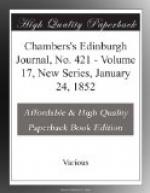There is no means of accurately determining the intrinsic value of our importation of ivory—the price is so variable. In 1827, upwards of 3000 cwt.; in 1842, upwards of 5000 cwt.; and in 1850, about 8000 cwt. was imported, of which about four-fifths was entered for home consumption. In point of quantity or bulk it is not calculated to attract attention, nor does the commercial transaction excite much notice. A quiet advertisement in the front page of the Economist, a few letters from London, Birmingham, and Sheffield to City brokers—for the ivory-trade is confined to a very small number of houses—and a cargo of African or Indian ivory, amounting perhaps to L.50,000 sterling, is quickly and easily disposed of. The supply at this moment is unequal to the demand, and the price is steadily advancing.
Small teeth weighing from 4 to 20 lbs. are worth from L.10 to L.16 per cwt.; and the price of the enormous tusks we have referred to, which are far beyond the limits of the above scale, is probably equal to L.50 per cwt. or upwards. African is worth about 25 per cent. more than Indian ivory of corresponding size and quality.
To attempt even to catalogue the extremely diversified uses to which ivory is applied would of itself be no easy task. There is not perhaps in the whole commercial list an article possessed of wider relations. It is extensively consumed in the manufacture of handles to knives and forks, and cutlery of every description; combs of all kinds; brushes of every form and use; billiard-balls, chess-men, dice, dice-boxes; bracelets, necklaces, rings, brooches; slabs for miniature portraits, pocket-tablets, card-cases; paper-knives, shoeing-horns, large spoons and forks for salad; ornamental work-boxes, jewel-caskets, small inlaid tables; furniture for doors and cabinets; pianoforte and organ keys; stethoscopes, lancet-cases, and surgical instruments; microscopes, lorgnettes, and philosophical instruments; thermometer scales, hydrometer scales, and mathematical instruments; snuff-boxes, cigar-cases, pipe-tubes; fans, flowers, fancy boxes; crucifixes, crosiers, and symbols of faith; idols, gods, and symbols of superstition; vases, urns, sarcophagi, and emblems of the dead; temples,




